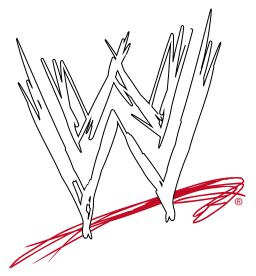 |
| WWE current logo |
World Wrestling Entertainment, Inc. (doing business as
WWE, Inc.;)
is an American publicly traded, privately controlled entertainment
company dealing primarily in professional wrestling, with major revenue
sources also coming from film, music, product licensing, and direct
product sales. It is currently the largest professional wrestling
promotion in the world, reaching 13 million viewers in the U.S. and
broadcasting its shows in 30 languages to more than 145 countries.
Like other professional wrestling promotions, WWE's shows do not
feature legitimate sporting contests. Instead, its programs feature
storyline-driven combat sport matches with predetermined outcomes and
fighting maneuvers that are worked, all promoted as legitimate bouts.
Vince
McMahon is the majority owner, chairman and chief executive officer
(CEO) of the company. Together with his wife Linda McMahon, and their
children Shane McMahon and Stephanie McMahon-Levesque (WWE Executive
Vice President of Creative), the McMahons hold approximately 70% of
WWE's economic interest and 96% of the voting power in the company. The
company's headquarters are located in Stamford, Connecticut with offices
in New York City, Los Angeles, London, Shanghai, Tokyo, Singapore, and
Mumbai.
WWE
holds an extensive library of videos, representing a significant
portion of the visual history of professional wrestling. The company
began as the
Capitol Wrestling Corporation in 1952, which promoted under the banner of the
World Wide Wrestling Federation (WWWF) and later the
World Wrestling Federation (WWF). In 1982, it was sold to the same family's Titan Sports company, which later changed its name to
World Wrestling Federation Entertainment, before becoming
World Wrestling Entertainment in 2002, and simplified to
WWE in 2011.
Company history
Capitol Wrestling Corporation (1952-1963)
Roderick
James "Jess" McMahon was a boxing promoter whose achievements included
co-promoting a bout in 1915 between Jess Willard and Jack Johnson. In
1926, while working with Tex Rickard (who actually despised wrestling to
such a degree he prevented wrestling events from being held at the
third Madison Square Garden
in New York City between 1939 and 1948), he started promoting boxing at
the Garden. The first match during their partnership was a
light-heavyweight championship match between Jack Delaney and Paul
Berlenbach.
A few years earlier, around 1920, professional
wrestler Joseph Raymond "Toots" Mondt
had created a new challenge of professional wrestling that he called
Slam Bang Western Style Wrestling to make the entertainment more
appealing to spectators. At the time, pro wrestling consisted primarily
of mat grappling; and while the sport had flourished a decade earlier
under Frank Gotch, the fans had since grown tired of the painfully
deliberate pace of the bouts. However, Mondt discovered a solution that
would completely transform the industry, as he convinced Lewis and
Sandow to implement a new form of wrestling that combined features of
boxing, Greco-Roman, freestyle, lumber-camp fighting, and theater into
what he deemed “Slam Bang Western-Style Wrestling.” He then formed a
promotion with wrestler Ed Lewis and his manager Billy Sandow. They
persuaded many wrestlers to sign contracts with their Gold Dust Trio.
After much success, a disagreement over power caused the trio to
dissolve and, with it, their promotion. Mondt formed partnerships with
several other promoters, including Jack Curley
in New York City. When Curley was dying, Mondt moved to take over New
York wrestling with the aid of several bookers, one of whom was Jess
McMahon.

Together, McMahon and Mondt created the
Capitol Wrestling Corporation Ltd.
(CWC). The CWC joined the National Wrestling Alliance in 1953. In
November 1954, Jess McMahon died, and Ray Fabiani, one of Mondt's
associates, brought in Vincent James McMahon to replace his father in
the promotion.McMahon
and Mondt were a successful combination, and within a short
time, they controlled approximately 70% of the NWA's booking, largely
due to their dominance in the heavily populated Northeast region. Mondt
taught McMahon about booking and how to work in the wrestling business.
Due to the dominance in the northeast, the CWC was referred to by AWA
legend Nick Bockwinkel as the "Northeast Triangle", with its territory
being defined by Pittsburgh, Washington, D.C., and Maine as points of
the triangle.
World Wide Wrestling Federation (1963-1979)
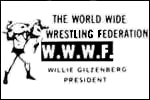 |
| The official WWWF logo from 1963 to 1979 |
The NWA recognized an undisputed NWA World Heavyweight Champion
that went to several different wrestling companies in the alliance and
defended the belt around the world. The NWA generally promoted strong shooters
as champions, to give their worked sport credibility and guard against
double-crosses. While doing strong business in the Midwest (the
Alliance's core region), these wrestlers attracted little interest in
the Capitol territory. In 1961, the NWA board decided instead to put the
belt on bleach blonde showman "Nature Boy" Buddy Rogers, a much more effective drawing card in the region.
The rest of the NWA was unhappy with Mondt because he rarely allowed
Rogers to wrestle outside of the Northeast. Mondt and McMahon wanted
Rogers to keep the NWA World Championship, but Rogers was unwilling to
sacrifice his $25,000 deposit on the belt (title holders at the time had
to pay a deposit to insure they honored their commitments as champion).
Rogers lost the NWA World Championship to Lou Thesz
in a one-fall match in Toronto, Ontario on January 24, 1963, which led
to Mondt, McMahon, and the CWC leaving the NWA in protest, creating the
World Wide Wrestling Federation (WWWF) in the process.
In
April, Rogers was awarded the new WWWF World Championship following an
apocryphal tournament in Rio de Janeiro. He lost the title to Bruno
Sammartino a month later on May 17, 1963, after suffering a heart attack
shortly before the match. To accommodate Rogers' condition, the match
was booked to last under a minute.
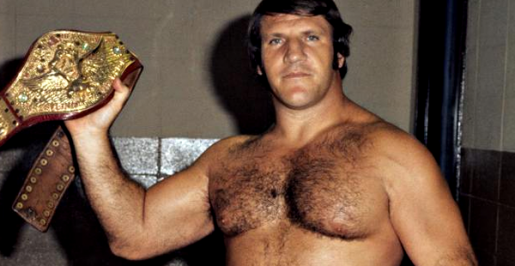 |
| Bruno Sammartino |
Two years later, NWA president Sam Muchnick
and McMahon discussed a unification match between Thesz and Sammartino,
with both parties agreeing to Sammartino winning the unified title. The
match plans fell apart when Sammartino refused to take on the enlarged
schedule and Thesz demanded a high guarantee for doing the job.
The WWWF operated in a conservative matter compared to other pro wrestling territories;
it ran its major arenas monthly rather than weekly or bi-weekly,
usually featuring a babyface champion wrestling various heels in
programs consisting of one to three matches, with the initial meeting
often featuring a heel win in a non-decisive manner. Although business
was initially rather strong, crowds in Madison Square Garden
fell off due to a lack of television exposure. After gaining a
television program on a Spanish-language station, and turning
preliminary wrestler Lou Albano
as a manager for Sammartino's heel opponents, the WWWF was doing
sellout business by 1970. Albano was soon joined by fellow managers
Ernie Roth and Freddie Blassie, forming the "Triumverate of Terror,"
managing heel opponents for Sammartino and later champions Pedro Morales
and Bob Backlund. Heels such as Ivan Koloff and Stan Stasiak were used
to transition the title from one babyface to another; "Superstar" Billy
Graham
enjoyed a nine and a half month reign as a heel champion, as McMahon
felt he would need this much time to build up Bob Backlund as
championship material.
Mondt
left the company in the late sixties. Although the WWWF had
withdrawn from the NWA, Vince McMahon, Sr. quietly rejoined the
organization in 1971, although he did not book an NWA world champion in
his territory until Harley Race in the late 1970s. At the annual meeting
of the NWA in 1983, the McMahons and WWF employee Jim Barnett all
withdrew from the organization.
In March 1979, for marketing purposes, the World Wide Wrestling Federation was renamed the
World Wrestling Federation (WWF).
Titan Sports, Inc. (1980-1999)
World Wrestling Federation
 |
| Vince McMahon, founder of Titan Sports, Inc. and current Majority owner, Chairman, and CEO of WWE. |
On February 21, 1980, the son of Vincent J. McMahon, Vincent K. McMahon, founded Titan Sports, Inc. and on June 6, 1982, purchased Capitol Wrestling Corporation Ltd. from his father and other stock holders (Arnold Skaaland, Gorilla Monsoon, and Phil Zacko).
The elder McMahon had long since established the northeastern territory
as one of the most vibrant members of the NWA. He had long since
recognized that professional wrestling was more about entertainment than actual sport. Against his father's wishes, McMahon began an expansion process that fundamentally changed the industry.
The
WWF was not the only promotion to have broken ranks with the NWA; the
American Wrestling Association
(AWA) had long ago ceased being an official NWA member (although like
the WWF, they seldom left their own territory). However, neither of the
defecting members attempted to undermine the territory system that had
been the foundation of the industry for more than half a century.
Other
promoters were furious when McMahon began syndicating WWF television
shows to television stations across the United States, in areas outside
of the WWF's traditional northeastern stronghold. McMahon also began
selling videotapes of WWF events outside the Northeast through his
Coliseum Video
distribution company. He effectively broke the unwritten law of
regionalism around which the entire industry had been based. To make
matters worse, McMahon used the income generated by advertising,
television deals, and tape sales to poach talent from rival promoters.
Wrestling promoters nationwide were now in direct competition with the
WWF.
Hulk Hogan, due to his appearance in
Rocky III, had a
national recognition that few other wrestlers could offer, which is what
led McMahon to sign him. Roddy Piper was brought in, as well as Jesse
Ventura
(although Ventura rarely wrestled in the WWF at that point due to the
lung disorder that caused his retirement, moving to the commentator
booth alongside Gorilla Monsoon). André the Giant, Jimmy Snuka, Don
Muraco, Paul Orndorff, Greg Valentine, Ricky Steamboat, and the Iron
Sheik (Hossein Khosrow Ali Vaziri) rounded out the roster. Hogan was
clearly McMahon's biggest star, causing some people to debate whether the WWF could have achieved national success without him.
 |
| The original logo for the company. |
The WWF would tour nationally in a venture that
required huge capital
investment; one that placed the WWF on the verge of financial collapse.
The future of not just McMahon's experiment, but also the WWF, the NWA,
and the whole industry came down to the success or failure of McMahon's
groundbreaking concept, WrestleMania. WrestleMania was a pay-per-view
extravaganza (in some areas; most areas of the country saw WrestleMania
available on closed-circuit television) that McMahon marketed as being
the Super Bowl of professional wrestling. The concept of a wrestling
supercard was nothing new in North America; the NWA had been running
Starrcade a few years prior to WrestleMania, and even the elder McMahon
had marketed large Shea Stadium cards
viewable in closed-circuit locations. However, McMahon's vision was to
make the WWF and the industry itself mainstream, targeting more of the
general television audience by exploiting the entertainment side of the
industry. With the inaugural WrestleMania the WWF initiated a
joint-promotional campaign with MTV, which featured a great deal of WWF
coverage and programming, in what was termed the
Rock 'n' Wrestling Connection.
The mainstream media attention brought on by celebrities including
Muhammad Ali, Mr. T, and Cyndi Lauper at the event helped propel
WrestleMania to become a staple in popular culture.
The original WrestleMania,
held in 1985, was a resounding success. This event is sometimes
credited as the debut of what McMahon called "sports entertainment", in
contrast to his father's preference of pure wrestling. The WWF did
incredible business on the shoulders of McMahon and his all-American babyface hero, Hulk Hogan,
for the next several years, creating what some observers dubbed a
second golden age for professional wrestling. The introduction of
Saturday Night's Main Event on NBC
in mid-1985 marked the first time that professional wrestling had been
broadcast on network television since the 1950s. In 1987, the WWF
produced what was considered to be the pinnacle of the 1980s wrestling
boom, WrestleMania III.
A rematch of the Wrestlemania III feature bout, once again pitting
Champion Hulk Hogan against Andre the Giant on Main Event, was seen by
33 million people, which is still the record for the most watched
wrestling match in North America.
New Generation
 |
| The logo used to represent the "New Generation" era between 1994 to 1998. |
The WWF hit a low point in the wake of allegations of
steroid abuse and distribution made against it in 1994; there were also
allegations of sexual harassment made by WWF employees. McMahon was
eventually exonerated, but it was a public relations
nightmare for the WWF. The steroid trial cost the WWF an estimated $5
million at a time when revenues were at an all-time low. To compensate,
McMahon cut the pay of both wrestlers and front office personnel – close
to 40% in the latter case (and about 50% for top level managers such as
Bobby Heenan and Jimmy Hart, who both left). This helped drive many WWF
wrestlers to its only major competition, World Championship Wrestling
(WCW), between 1994 and 1997. During this period, the WWF promoted
itself under the banner of "The New WWF Generation," featuring Shawn
Michaels, Diesel, Razor Ramon, Bret Hart, and The Undertaker.
In an effort to promote them and other young talent as the new
superstars of the ring, the WWF began to play on the age restrictions
which former WWF wrestlers such as Hulk Hogan and Randy Savage
(who by now were working for WCW) now faced. This is best seen in the
"Billionaire Ted" parodies of early 1996 (a reference to WCW's owner and
patron, media mogul Ted Turner) which culminated in a "rasslin'" match
during the warm-up to WrestleMania XII.
Monday Night Wars
 |
| Monday Night Wars |
In 1993, the WWF broke new ground in televised professional wrestling with the debut of its cable program WWF Monday Night Raw. After becoming a runaway success, WCW countered in 1995 with its own Monday night cable program, WCW Monday Nitro, in the same timeslot as Raw. The two programs would trade wins in the ensuing ratings competition until mid-1996, when WCW began a nearly two-year domination that was largely fueled by the introduction of the New World Order, a stable led by former WWF performers Hulk Hogan, Scott Hall, and Kevin Nash.
The Attitude Era
 |
| The updated logo representing the "Attitude" era was introduced in December 1997 and was used until May 2002. |
The feuds and match types developed by the end of the
mid-1990s began
a new era in wrestling. The fans of WWF seemed to favor what was posed
to them as the bad guy instead of the good guy.
The creative changes made by the WWF creative board saw wrestling take
on a "street fighting", "bad attitude" approach; however, despite the
revolutionary changes in sports-entertainment that the WWF founded, 1997
remains the lowest of the WWF's financial income and a heavy loss in
fan interest to rival WCW. Through to present day many wrestlers
acknowledge that at the time, they were not aware of how close the
company came to liquidation. Throughout 1996 and 1997, the WWF lost much
of its leading talent to WCW, including Razor Ramon (Scott Hall),
Diesel (Kevin Nash), Sycho Sid (Sid Eudy), Alundra Blayze (Debrah
Miceli), and Rick Rude (Richard Rood). The WWF replaced them with former
WCW talent such as Vader (Leon White), Stone Cold Steve Austin, Brian
Pillman, Mankind (Mick Foley), and Faarooq (Ron Simmons).
Eric Bischoff's public humiliation of the WWF, criticizing them for
signing WCW's sacked wrestlers and bragging that WWF wrestlers were
signing for WCW due to higher pay, intensified the Monday Night Wars
only for
Nitro as the WWF struggled to regain its popularity.
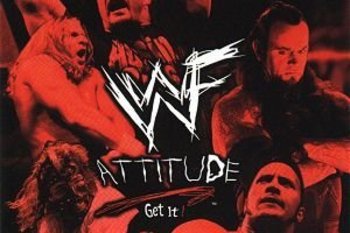
McMahon
managed to keep Bret Hart from reverting to WCW, and began a feud with
Hart and Steve Austin. In Hart's absence after WrestleMania XII, Steve
Austin became the new face of the company, starting with his Austin 3:16
speech, shortly after defeating Jake Roberts in the tournament finals
at the 1996 King of the Ring pay-per-view.
WrestleMania 13 saw Hart defeat Austin in a critically acclaimed
submission match, and shortly after saw Hart reform The Hart Foundation.
McMahon revolved the company around Hart, Austin and Shawn Michaels,
feuding with each other for the majority of the year, leaving many to
admire their impact carrying the business through a difficult time.
Despite his strong long running image as a face, the Canadian Hart was
turned heel
in an anti-USA gimmick, while Steve Austin became cheered by fans
despite efforts to design him as the ultimate heel, making him a
tweener. Rocky Maivia joined the Nation of Domination stable after fans
rejected his good guy image, and Shawn Michaels formed the street gang
faction D-Generation X with Triple H and Chyna;
similar to the Stone Cold Steve Austin character, DX was designed not
to care for what the fans or other wrestlers thought of them. Michaels
later stated that the concept of DX was brought about after he persuaded
McMahon to take a cruder approach to the company's marketing approach
following him fining Michaels $10,000 for putting large ornaments in his
shorts and exploiting his crotch around the ring during an on-air
interview. The Hell in a Cell match between Shawn Michaels and The
Undertaker produced a fresh strong foundation for the WWF's creative
board.

1997
ended with McMahon facing real life controversy resulting in
major ratings and financial losses after becoming widely despised by his
employees, wrestling critics, and wrestling fans following Bret Hart's
controversial departure from the WWF, later known as the Montreal
Screwjob. This proved to be a founding factor in what was to officially
kick start The Attitude Era.
By
January 1998, the WWF began broadcasting more violence, swearing,
and more edgy angles in its attempt to compete with WCW. Following Bret
Hart's departure, Vince McMahon used the resulting backlash in the
creation of his "Mr. McMahon" character, a dictatorial
and fierce ruler who favored heels who were "good for business" over
"misfit" faces like Austin. This, in turn, led to the Austin vs. McMahon
feud, which, along with D-Generation X who briefly hired Mike Tyson in
the buildup to WrestleMania XIV,
officially began the Attitude Era. It also featured the established
Monday Night Wars, where both WCW and the WWF had Monday night shows
that competed against each other in the ratings, and saw the WWF finally
beat WCW for the first time in 84 weeks when McMahon made his in-ring
debut against Austin. The evolution of more brutal matches with
different stipulations to increase viewership worked to a major extent,
mainly through the furthering of Hell in a Cell (notably its second
appearance featuring The Undertaker vs. Mankind) and the Inferno match
(introduced by Kane against The Undertaker). Many wrestlers such as
Chris Jericho and The Radicalz (Chris Benoit, Eddie Guerrero, Perry
Saturn, Dean Malenko)
were drafted from WCW, all publicly claiming on both companies' TV
broadcasts that they were extremely unhappy at the storylines and
backstage chaos at WCW, and were further intrigued and happier with the
structural running of the WWF. The 1996 Olympic gold medalist, Kurt
Angle,
The Rock (renamed from Rocky Maivia), and Mick Foley (as Mankind,
Cactus Jack and Dude Love) were successfully re-invented to compete at
the main event level. Notably, Mick Foley's WWF Championship win over
The Rock on
Monday Night Raw saw WCW lose millions of viewers
when WCW President Eric Bischoff instructed announcer Tony Schiavone to
give away the result minutes before both main events started, which led
to
Raw drawing eleven million viewers.
World Wrestling Federation Entertainment, Inc. (1999-2002)
Initial public offerings
 |
| Smack Down Current Logo |
On the back of the success of the Attitude Era, several new advances
and products were launched. During this period, the WWF's parent company
Titan Sports was renamed
World Wrestling Federation Entertainment, Inc. (
WWFE Inc. or
WWFE) and on October 19, 1999 became a publicly traded company, offering 10 million shares priced at $17 each.
WWF Entertainment announced its desire to diversify, including creating
a nightclub in Times Square, producing feature films, and book
publishing.
On April 29, 1999, the WWF made its return to terrestrial television by launching a special program known as
SmackDown! on the fledgling UPN
network. The Thursday night show became a weekly series on August 26,
1999. The show led to further TV ratings competition with WCW, up
against WCW Thunder.
In 2000 the WWF, in collaboration with
television network NBC, announced the creation of the XFL, a new
professional football league that debuted in 2001.
The league had high ratings for the first few weeks, but initial
interest waned and its ratings plunged to dismally low levels (one of
its games was the lowest-rated prime-time show in the history of
American television). NBC walked out on the venture after only one
season, but McMahon intended to continue alone. However, after being
unable to reach a deal with UPN, McMahon shut down the XFL.
Acquisition of WCW and ECW
 |
| ECW Logo |
By the fall of 1999, The Attitude Era had turned the
tide of the
Monday Night Wars into WWF's favor for good. After Time Warner merged
with AOL, Ted Turner's
control over WCW was considerably reduced, and the newly merged company
announced a complete lack of interest in professional wrestling as a
whole, and decided to sell WCW in its entirety. Although Eric
Bischoff—whom Time Warner fired as WCW president in October 1999—was
nearing a deal to purchase the company complete, in March 2001, WWF
Entertainment, Inc. acquired WCW from AOL Time Warner for a number
reported to be around $7 million. Shortly after WrestleMania X-Seven,
the WWF launched the Invasion storyline integrating the incoming talent
roster from WCW and Extreme Championship Wrestling
(ECW). With this purchase, WWF now became the largest wrestling
promotion in the world, and the only one in North America with
mainstream exposure. The assets of ECW, which had folded after filing
for bankruptcy protection in April 2001, were purchased by WWE in
mid-2003.
World Wrestling Entertainment, Inc. / WWE, Inc. (2002-present)
Brand extension
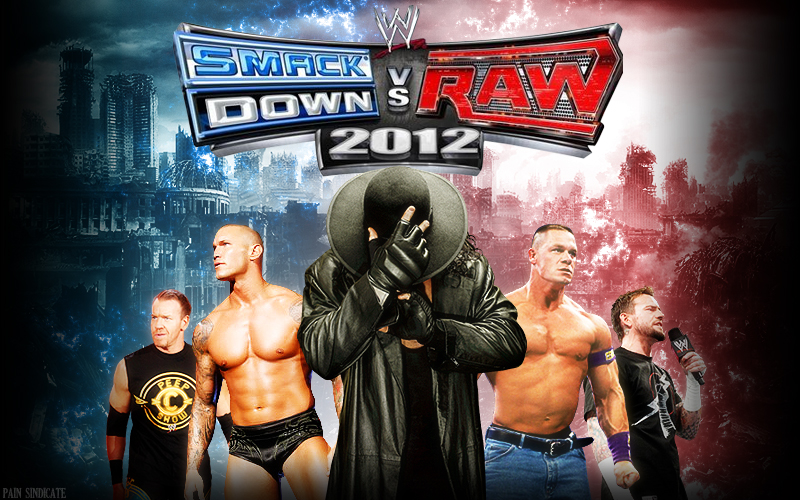
In March 2002, roughly two months before the name change, WWE decided to create two separate rosters,
Raw and
SmackDown!
due to the overabundance of talent left over from the Invasion
storyline. This is known as the WWE Brand Extension.
Despite much of the originally drafted talent departing by 2004, WWE
has continued to separate the shows, taking on younger talent, and holds
a Draft Lottery every year. On May 26, 2006, WWE announced the relaunch
of Extreme Championship Wrestling as a WWE brand. The new ECW program
aired internationally and on Tuesday nights on Syfy in the United States
until February 16, 2010.
Name dispute
 |
| The "Get the F Out" marketing campaign |
In 2000, the World Wide Fund for Nature (also
trademarked WWF), an environmental organization, sued World Wrestling
Federation Entertainment Inc. in the United Kingdom. The Law Lords
agreed that the promotion company had violated a 1994 agreement as
Titan Sports which had limited the permissible use of the WWF trademark
in Europe, particularly in merchandising. The World Wide Fund and World
Wrestling Federation used the initials since March 1979.
The last televised event to market the WWF logo was the UK based
pay-per-view Insurrextion 2002. On May 5, 2002, the company launched its
"Get The F Out" marketing campaign and changed all references on its
website from "WWF" to "WWE", while switching the URL from
WWF.com to
WWE.com. The next day, a press release announced the official name change from
World Wrestling Federation Entertainment, Inc. to
World Wrestling Entertainment, Inc., or WWE, and the change was publicized later that day during a telecast of
Monday Night Raw, which was broadcast from the Hartford Civic Center in Hartford, Connecticut.
Following the case, the use of the WWF "scratch" logo became
prohibited on all WWE properties. Additionally, past references to the
WWF trademark and initials in 'specified circumstances' became censored.
Despite litigation, WWE was still permitted use of the original WWF
logo, which was used from 1979 through 1994, as well as the "New WWF
Generation" logo, which was used from 1994 through 1998. Furthermore,
the company could still make use of the full "World Wrestling
Federation" and "World Wrestling Federation Entertainment" names without
consequence. In 2003, WWE won a limited decision to continue marketing
certain classic video games from THQ and Jakks Pacific that contained the WWF "scratch" logo. However, the packaging on those games had all WWF references replaced with WWE.
 |
| WWE logo, retrofitted as the classic logo |
Starting with the 1,000th episode of
Raw in July 2012, the WWF
"scratch" logo is no longer censored in archival footage due to WWE
reaching a settlement with the World Wide Fund for Nature.
In addition, references to the "WWF" initials are no longer censored
when spoken or when written in plain text in archival footage. Since
then, full-length matches and other segments featuring the WWF initials
and "scratch" logo have been added to the WWE website and the WWE
Classics on Demand service. This also includes WWE Home Video releases
since October 2012 starting with the re-release of
Brock Lesnar: Here Comes The Pain.
In exchange, WWE is no longer permitted to use the WWF initials or logo
in any new, original footage, with any old-school logos for
retro-themed programming now using the original WWF logo, but modified
without the F.
Network changes and high-definition
 |
| WWE pay per view logo |
In late 2005, WWE Raw returned after a five-year
stint on TNN (now Spike) to its original home USA Network. In 2006, due
to contracts with NBC Universal, parent company of USA Network, WWE
revived its classic Saturday night show Saturday Night's Main Event
(SNME) on NBC
after a thirteen-year hiatus. WWE had the chance to promote the company
on a major national network rather than the lower profile CW
or cable channels like USA Network. SNME airs occasionally on NBC as a
WWE special series. On September 26, 2007, it was announced that WWE
would be expanding its international operations. Alongside the current
international offices in London and Toronto, a new international office
would be established in Sydney.
On January 21, 2008, WWE made the transition to high-definition
(HD). All TV shows and pay-per-views after this were broadcast in HD.
In addition, WWE also introduced a new HD set that is used for both the
Raw and
SmackDown
brands. A different set, though usually similar to the universal design
in layout, is used for pay-per-views. On July 23, 2012,
Raw debuted a new, modified HD set which has also become universal for all weekly programming.
Social Media, TV-PG, and Public Service Initiatives
 |
| WWE Fan Nation Logo |
On November 19, 2008, WWE launched their online social network, WWE Universe. It initially appeared in April as
WWE Fan Nation. Similar to Myspace,
it offered blogs, forums, and other features for WWE fans. Also the WWE
fanbase began being referred to on-air by the announcers and wrestlers
as the "WWE Universe", similar to how some sports franchises refer to
their own fanbases ("Red Sox Nation", "Raider Nation", etc.). The social network ceased operations on January 1, 2011. The company subsequently launched a WWE page on Facebook,
which, as of October 7, 2011, had more than 39 million fans worldwide.
In 2012, WWE became an investor in the social media site Tout, which is now heavily promoted on all programming.
Also
in 2008, WWE initiated a change in its programming content. The United
States parental guidelines rating system now rates most WWE television
programs TV-PG. This was done to promote more family-friendly content in
the programming than in the past (especially during the Attitude Era)
when most content was rated TV-14. As part of this new policy, WWE
television programs shift to black-and-white if a wrestler blades in
front of the camera. And in 2012, WWE debuted a new Saturday morning program (
WWE Saturday Morning Slam) which is rated TV-G and has special restrictions barring the use of holds and moves aimed at the neck. Vince McMahon noted that the change to more family-friendly content is due to the changing demographics in WWE viewership.
With the adjustment made to on-air content, WWE also began to get
more involved in public service and community outreach programs, such as
in 2011, when WWE (along with several other groups) began the "Be A
Star" anti-bullying initiative. And in 2012, WWE formed a partnership
with Susan G. Komen for the Cure to promote breast cancer
awareness. As part of the campaign, WWE adorned their sets with pink
ribbons, put a pink middle rope on the ring, filmed numerous PSAs, and
sold special John Cena
"Rise Above Cancer" merchandise. All of these efforts culminated in a
donation from WWE of $1 Million, which was presented to Susan G. Komen
representatives in an in-ring ceremony during the October 29, 2012
episode of
Raw. In 2013, WWE became involved in the Nothing But
Nets program, which involves providing and distributing mosquito nets in
Africa to prevent insect bites which may cause malaria.
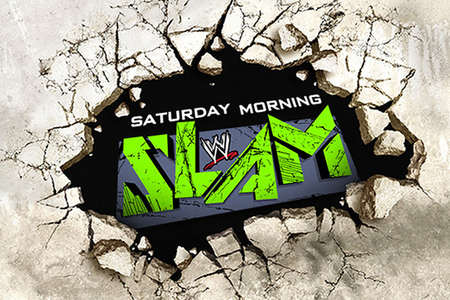 |
| Saturday Morning Slam Logo |
On April 7, 2011, WWE Corporate announced that the company would be
rebranded from "World Wrestling Entertainment, Inc." to simply "WWE,
Inc." This orphan initialism
occurred to reflect WWE's global entertainment expansion away from the
ring with the ultimate goal of acquiring entertainment companies and
putting a focus on television, live events, and film production. WWE
quoted that their new company model was put into effect with the
relaunch of
WWE Tough Enough, being a non–scripted program
(contrary to the scripted nature of professional wrestling) and with the
expected launch of a WWE television network in 2012. However, the legal
name of the company remains as World Wrestling Entertainment.
Beginning October 2012, WWE programs
SmackDown,
NXT,
Main Event &
Superstars are available in full on Hulu while only half of
Raw can be viewed.
"Supershow" format and developmental restructuring
Beginning with the August 29, 2011, episode of
Raw, it was announced that
Raw would feature talent from both
Raw and
SmackDown, and would be known as
Raw Supershow (the "Supershow" suffix would be dropped on July 23, 2012). The next night, on a special live episode of
SmackDown, a similar announcement was made regarding
Raw talent appearing on
SmackDown.
Also, championships previously exclusive to one show or the other
became available for wrestlers from any show to compete for, as well as
house show cards also featuring a mix of both
Raw and
SmackDown
talent. For all intents and purposes, the "Supershow" format would mark
the end of the brand extension, as all programming and live events
since the initial announcement was made have featured the full WWE
roster.
 |
| NXT Tag Team Championship |
On March 20, 2012, rumors circulated online reporting
that WWE would cease operation of its lone development territory,
Florida Championship Wrestling, in three weeks time.
However, the next day (March 21) WWE's Executive Vice President of
Talent, Paul "Triple H" Levesque, in a statement on WWE.com, revealed
that rumors of the impeding closing of FCW were not true, and after
WrestleMania XXVIII
there would be a big announcement regarding the development system of
the company. In August 2012, FCW was revamped by having its name changed
to NXT Wrestling (the name of a WWE program which showcases
developmental talent), and by establishing new championships for the
developmental roster (the NXT Championship and the NXT Tag Team
Championship).
Wellness Program
 |
| Eddie Gurrero |
The Talent Wellness Program is a comprehensive drug,
alcohol, and
cardiac screening program initiated in February 2006, shortly after the
sudden death of one of their highest profile talents, 38 year-old Eddie
Guerrero. The policy tests for recreational drug use and abuse of
prescription medication, including anabolic steroids
.
Under the guidelines of the policy, talent is also tested annually for
pre-existing or developing cardiac issues. The drug testing is handled
by Aegis Sciences Corporation. The cardiac evaluations are handled by
New York Cardiology Associates P.C.
After the double murder and
suicide committed by one of its performers, Chris Benoit, with a
possible link to steroids abuse encouraged by WWE, the United States
House Committee on Oversight and Government Reform requested that WWE
turn over any material regarding its talent wellness policy.
In August 2007, the program was defended by WWE and its employees in
the wake of several illegal pharmacy busts that linked WWE performers to
steroid purchases even after the policy was put into place. Ten
professional wrestlers were suspended for violating the Wellness Policy
after reports emerged they were all customers of Signature Pharmacy in Orlando, Florida.
According to a statement attributed to WWE attorney Jerry McDevitt, an
eleventh wrestler was later added to the suspension list.
Because
of the Wellness Policy, physicians were able to diagnose one
of its performers with a heart ailment that otherwise would have likely
gone unnoticed until it was too late. In August 2007, then-reigning
United States Champion Montel Vontavious Porter (real name Hassan Assad)
was diagnosed with Wolff–Parkinson–White syndrome,
which can be potentially fatal if gone undiagnosed. The ailment was
discovered while Assad was going through a routine Wellness Policy
checkup.
On September 13, 2010, WWE updated their list of banned substances to include muscle relaxers.
TNA Entertainment, LLC lawsuit
 |
| TNA |
In May 2012, TNA filed a lawsuit against WWE and former TNA employee
Brian Wittenstein, claiming that he took "confidential trade secrets" to
WWE and helped WWE gain an "unfair" competitive advantage in
negotiating contracts with TNA talent. According to the suit, TNA was
informed of Wittenstein's breach three weeks later by a WWE official,
after which the promotion fired Wittenstein. According to TNA, Ric Flair
attempted to terminate his TNA contract two days after Wittenstein's
firing. The exact allegations filed by TNA in the suit include
"interference with existing contracts", breach of duty of loyalty,
conversion, breach of contract, civil conspiracy, unfair competition,
and violation of the Tennessee Uniform Trade Secrets Act. An injunction hearing is set for July 12
Expansion beyond wrestling
In
addition to licensing wrestling and performers' likenesses to companies
such as Acclaim, THQ/2K Sports, and Mattel to produce video games and
action figures, WWE has moved into other areas of interest in order to
market their product.
Active properties
- WWE Libraries:
A subsidiary of WWE established in 2001 after the acquisition of WCW
that owns the largest collection of professional wrestling videos and
copyrights.
- WWE Studios: A subsidiary of WWE created in 2002 to create and develop feature film properties. Formerly known as WWE Films.
- WWE Music Group:
A subsidiary that specializes in compilation albums of WWE wrestlers'
entrance themes. The group also releases titles that have been performed
by WWE wrestlers.
- WWE Home Video:
A subsidiary that specializes in distributing compilation VHS, DVD, and
Blu-ray Disc copies of WWE pay-per-view events, compilations of WWE
wrestlers' performances, and biographies of WWE performers.
- WWE Books:
A subsidiary of WWE that serves to publish autobiographies of and
fiction based on WWE personalities, behind-the-scenes guides to WWE,
illustrated books, calendars, young adult books, and other general
"Nonfiction" books.
- WWE Kids: A website and comic set aimed at the children's end of the
wrestling market, comics are produced bi-monthly. It was launched on
April 15, 2008.
- WWEShop.com: A website located at http://shop.wwe.com/
Defunct properties
- World Bodybuilding Federation; A subsidiary of Titan Sports launched
in 1990 which promoted professional bodybuilding through a television
show, magazine, and annual pay-per-view events. Closed in 1992.
- XFL: Folded in 2001, a partially owned subsidiary of WWFE launched
in 2000 which comprised eight league-owned professional football teams.
The league included television broadcasts on NBC (the other co-owners of
the league), UPN and TNN.
- The World,
formerly known as WWF New York: A restaurant, night club, and
memorabilia shop in New York City launched in 1999. Closed in 2003. Hard Rock Cafe took the building itself since 2005.
- WWE Niagara Falls: A retail and entertainment establishment that was
located in Niagara Falls, Ontario and owned by WWE. It was open from
August 2002 through March 2011.
List of WWE pay-per-view events
Current pay-per-view events
| Month |
Event |
First year |
| January |
Royal Rumble |
1988 |
| February |
Elimination Chamber |
2010 |
| March/April |
WrestleMania |
1985 |
| May |
Extreme Rules |
2009 |
| June |
Payback |
2013 |
| July |
Money in the Bank |
2010 |
| August |
SummerSlam |
1988 |
| September |
Night of Champions |
2007 |
| Early October |
Battleground |
2013 |
| Late October |
Hell in a Cell |
2009 |
| November |
Survivor Series |
1987 |
| December |
TLC |
2009 |
 |
| royal rumble winners |
Upcoming pay-per-view schedule
| Date |
Event |
Venue |
City |
|
|---|
| October 27, 2013 |
Hell in a Cell |
American Airlines Arena |
Miami, Florida |
|
| November 24, 2013 |
Survivor Series |
TD Garden |
Boston, Massachusetts |
|
| December 15, 2013 |
TLC |
Toyota Center |
Houston, Texas |
|
| January 26, 2014 |
Royal Rumble |
Consol Energy Center |
Pittsburgh, Pennsylvania |
|
| February 23, 2014 |
Elimination Chamber |
Target Center |
Minneapolis, Minnesota |
|
| April 6, 2014 |
WrestleMania XXX |
Mercedes-Benz Superdome |
New Orleans, Louisiana |
|

Themed pay-per-views
| Pay-per-view |
Feature |
|---|
| Current |
| Royal Rumble |
Main event is the Royal Rumble match |
| Elimination Chamber |
One or more of the main events are Elimination Chamber matches |
| Extreme Rules |
Many of the matches will either be "Extreme Rules" matches or will otherwise be variants of hardcore wrestling |
| Money in the Bank |
Two of the main events will be Money in the Bank ladder matches |
| Night of Champions |
Every title must be defended by its respective champion |
| Hell in a Cell |
One or more of the matches will be a Hell in a Cell match |
| Survivor Series |
A focus on elimination-style matches, particularly the traditional Survivor Series elimination tag-team match |
| TLC: Tables, Ladders & Chairs |
At least one of the matches will be a Tables, Ladders, and Chairs
match, while individual chair matches, ladder matches, and tables
matches may also be present | | |
| |
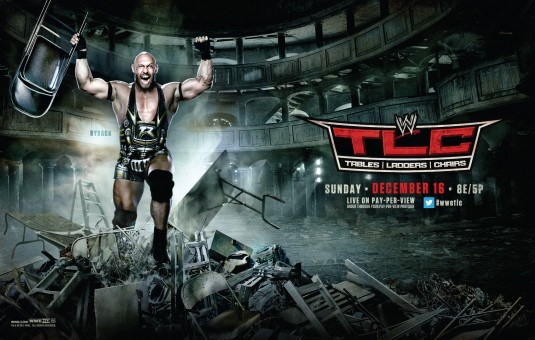 |
|---|
| Former |
|---|
| The Wrestling Classic |
The Wrestling Classic was a single-elimination tournament |
| King of the Ring |
The King of the Ring was a single-elimination tournament |
| Taboo Tuesday, later Cyber Sunday |
Fans were able to vote on the matches, such as opponents or stipulations |
| Breaking Point |
Many of the matches were focused on forcing your opponent to give up, either through submission matches or "I Quit" matches |
| Fatal 4-Way |
Many of the matches were fatal-four way matches |
| Bragging Rights |
The Raw and SmackDown brands would compete against one another for a
"Bragging Rights" trophy, and a 14-man tag team match between the two
brands would take place |
| Invasion |
All of the matches were between the WWF and The Alliance (WCW and ECW) |
| WWE One Night Stand |
The pay-per-views were themed around the old ECW promotion and so consisted of various hardcore matches |

Former pay-per-view events
| Pay-per-view |
Year(s) Active |
|---|
| This Tuesday in Texas |
1991 |
| King of the Ring |
1993–2002 |
| In Your House |
1995–1999 |
| Bad Blood |
1997, 2003–2004 |
| Over the Edge |
1998–1999 |
| Fully Loaded |
1998–2000 |
| Invasion |
2001 |
| One Night Stand |
2005–2008 |
| December to Dismember |
2006 |
| New Year's Revolution |
2005–2007 |
| Unforgiven |
1998–2008 |
| No Mercy |
1999–2008 |
| Cyber Sunday/Taboo Tuesday |
2004–2008 |
| Backlash |
1999–2009 |
| Judgment Day |
1998, 2000–2009 |
| The Great American Bash |
The Great American Bash (2004–2008),
The Bash (2009) |
| Breaking Point |
2009 |
| Fatal 4-Way |
2010 |
| Bragging Rights |
2009-2010 |
| Capitol Punishment |
2011 |
| Vengeance |
2001-2007, 2011 |
| No Way Out |
1998-2009, 2012 |
| Over The Limit |
2010 - 2012 | | | | | | |
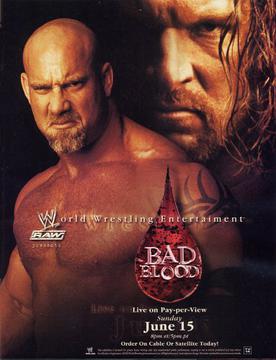
International pay-per-view events
| Event |
Year(s) Active |
Notes |
|---|
| UK Rampage |
1991-1993 |
Those events took place at London Arena, and were exclusive UK-only pay-per-views. |
| SummerSlam |
1992 only |
Summerslam 1992 took place at Wembley Stadium, London, England. |
| One Night Only |
1997 only |
The event took place in the UK in 1997. This was available in Europe and Canada only. |
| Mayhem in Manchester |
1998 only |
This was exclusive UK-only pay-per-view. |
| Capital Carnage |
1998 only |
The event took place in the UK in December of that year. |
| No Mercy (UK) |
1999 only |
The event took place in May of that year. Despite being held in the
UK, another PPV called "No Mercy" was held the same year in the U.S. |
| Rebellion |
1999–2002 |
The event took place in the UK in October 1999 and 2002, November 2001 and December 2000. |
| Insurrextion |
2000–2003 |
The event took place in the UK in May between 2000–2002 and June in 2003. |
| Global Warning |
2002 only |
The event took place in Australia on August 10, 2002. |
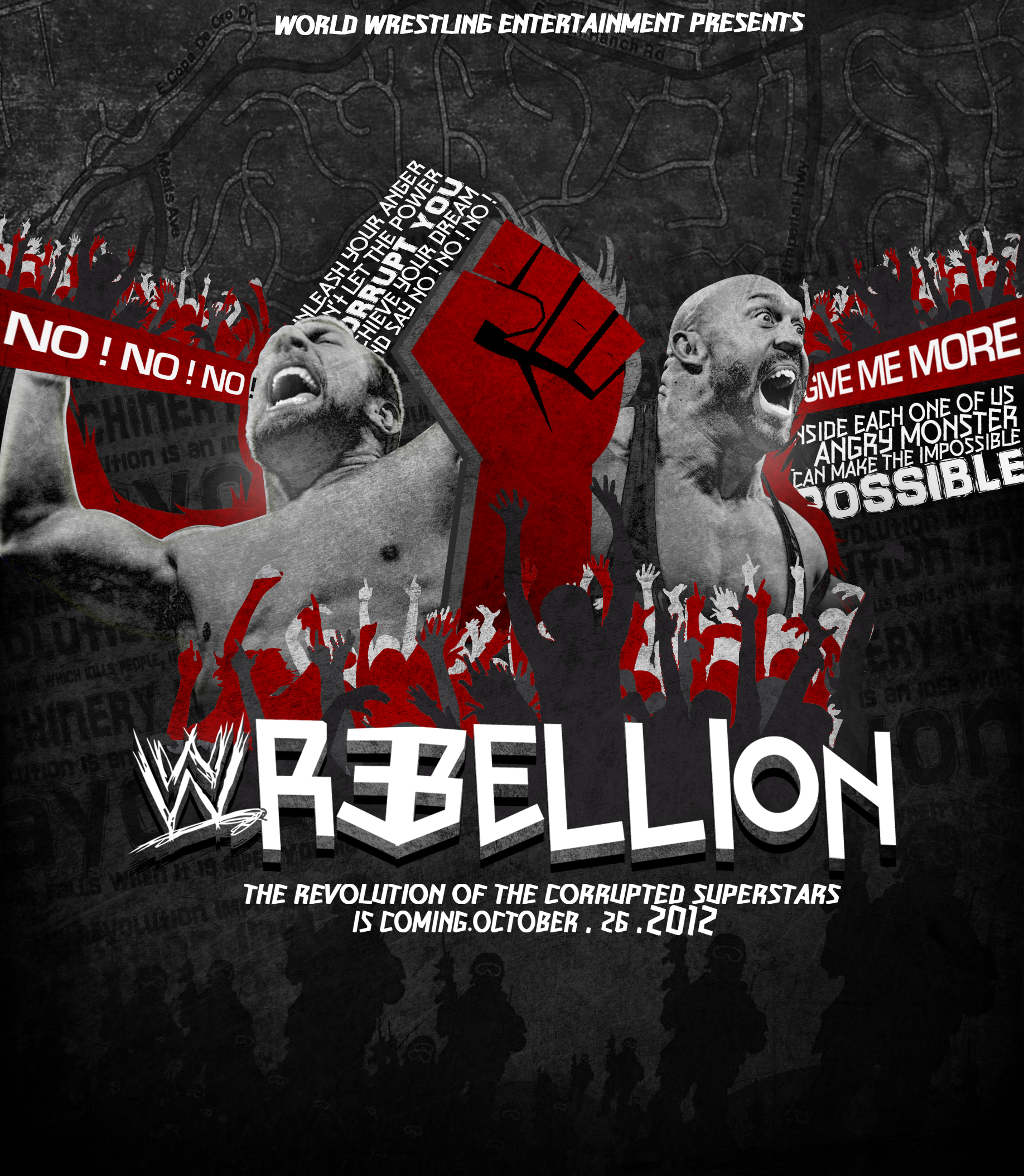
Championships and accomplishments
| Championship |
Current champion(s) |
Date won |
Event |
Previous champion(s) |
|---|
| WWE Championship |
Vacated |
September 16, 2013 |
Raw |
Daniel Bryan |
| World Heavyweight Championship |
Alberto Del Rio |
June 16, 2013 |
Payback |
Dolph Ziggler |
| Intercontinental Championship |
Curtis Axel |
June 16, 2013 |
Payback |
Wade Barrett |
| United States Championship |
Dean Ambrose |
May 19, 2013 |
Extreme Rules |
Kofi Kingston |
| Tag Team Championship |
The Shield
(Roman Reigns & Seth Rollins) |
May 19, 2013 |
Extreme Rules |
Team Hell No |
| Divas Championship |
AJ Lee |
June 16, 2013 |
Payback |
Kaitlyn |
|
|
|
|
|
|---|
|
|
|
|
|
|
|
|
|
|
|
|
|
|
|
|
|
|
|
|
|
|
|
|
|
|
|
|
|
|
Other accomplishments
| Accomplishment |
Latest winner |
Date won |
| Royal Rumble |
John Cena |
January 27, 2013 |
Money in the Bank
(WWE Championship) |
Randy Orton |
July 14, 2013 |
Money in the Bank
(World Heavyweight Championship) |
Damien Sandow |
July 14, 2013 |
Developmental territory champions
| Championship |
Current champion(s) |
Date won |
Event |
Previous champion(s) |
| NXT Wrestling |
| NXT Championship |
Bo Dallas |
May 23, 2013 |
NXT |
Big E Langston |
| NXT Tag Team Championship |
The Ascension
(Conor O'Brian and Rick Victor) |
September 12, 2013 |
NXT |
Adrian Neville & Corey Graves |
| NXT Women's Championship |
Paige |
June 20, 2013 |
NXT |
Inaugural |
Defunct championships
 |
| WWWF united states tag team champion |
In its 61 year history, WWE has operated over twenty
different championships. The company's first title, the WWWF United
States Tag Team Championship, was created in 1958 and retired in 1967.
Overall, the company has retired 19 championships with the most recent
being the WWE Women's Championship. Created in 1956 and retired in
September 2010, the consolidation of the WWE Unified Divas Championship
into the WWE's 2008 WWE Divas Championship retired the older title and
continued the lineage of the latter.
 |
| WWE Championship |
 |
| WWE world heavyweight championship |
 |
| WWE intercontinental championship |
 |
| WWE united states champioship |
 |
| WWE tag team championship |
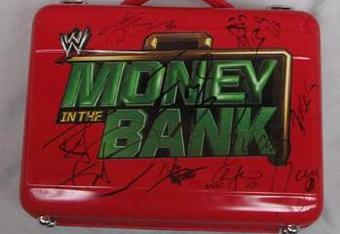 |
| WWE money in the bank briefcase |

 Together, McMahon and Mondt created the Capitol Wrestling Corporation Ltd.
(CWC). The CWC joined the National Wrestling Alliance in 1953. In
November 1954, Jess McMahon died, and Ray Fabiani, one of Mondt's
associates, brought in Vincent James McMahon to replace his father in
the promotion.McMahon
and Mondt were a successful combination, and within a short
time, they controlled approximately 70% of the NWA's booking, largely
due to their dominance in the heavily populated Northeast region. Mondt
taught McMahon about booking and how to work in the wrestling business.
Due to the dominance in the northeast, the CWC was referred to by AWA
legend Nick Bockwinkel as the "Northeast Triangle", with its territory
being defined by Pittsburgh, Washington, D.C., and Maine as points of
the triangle.
Together, McMahon and Mondt created the Capitol Wrestling Corporation Ltd.
(CWC). The CWC joined the National Wrestling Alliance in 1953. In
November 1954, Jess McMahon died, and Ray Fabiani, one of Mondt's
associates, brought in Vincent James McMahon to replace his father in
the promotion.McMahon
and Mondt were a successful combination, and within a short
time, they controlled approximately 70% of the NWA's booking, largely
due to their dominance in the heavily populated Northeast region. Mondt
taught McMahon about booking and how to work in the wrestling business.
Due to the dominance in the northeast, the CWC was referred to by AWA
legend Nick Bockwinkel as the "Northeast Triangle", with its territory
being defined by Pittsburgh, Washington, D.C., and Maine as points of
the triangle.






 McMahon
managed to keep Bret Hart from reverting to WCW, and began a feud with
Hart and Steve Austin. In Hart's absence after WrestleMania XII, Steve
Austin became the new face of the company, starting with his Austin 3:16
speech, shortly after defeating Jake Roberts in the tournament finals
at the 1996 King of the Ring pay-per-view.
WrestleMania 13 saw Hart defeat Austin in a critically acclaimed
submission match, and shortly after saw Hart reform The Hart Foundation.
McMahon revolved the company around Hart, Austin and Shawn Michaels,
feuding with each other for the majority of the year, leaving many to
admire their impact carrying the business through a difficult time.
Despite his strong long running image as a face, the Canadian Hart was
turned heel
in an anti-USA gimmick, while Steve Austin became cheered by fans
despite efforts to design him as the ultimate heel, making him a
tweener. Rocky Maivia joined the Nation of Domination stable after fans
rejected his good guy image, and Shawn Michaels formed the street gang
faction D-Generation X with Triple H and Chyna;
similar to the Stone Cold Steve Austin character, DX was designed not
to care for what the fans or other wrestlers thought of them. Michaels
later stated that the concept of DX was brought about after he persuaded
McMahon to take a cruder approach to the company's marketing approach
following him fining Michaels $10,000 for putting large ornaments in his
shorts and exploiting his crotch around the ring during an on-air
interview. The Hell in a Cell match between Shawn Michaels and The
Undertaker produced a fresh strong foundation for the WWF's creative
board.
McMahon
managed to keep Bret Hart from reverting to WCW, and began a feud with
Hart and Steve Austin. In Hart's absence after WrestleMania XII, Steve
Austin became the new face of the company, starting with his Austin 3:16
speech, shortly after defeating Jake Roberts in the tournament finals
at the 1996 King of the Ring pay-per-view.
WrestleMania 13 saw Hart defeat Austin in a critically acclaimed
submission match, and shortly after saw Hart reform The Hart Foundation.
McMahon revolved the company around Hart, Austin and Shawn Michaels,
feuding with each other for the majority of the year, leaving many to
admire their impact carrying the business through a difficult time.
Despite his strong long running image as a face, the Canadian Hart was
turned heel
in an anti-USA gimmick, while Steve Austin became cheered by fans
despite efforts to design him as the ultimate heel, making him a
tweener. Rocky Maivia joined the Nation of Domination stable after fans
rejected his good guy image, and Shawn Michaels formed the street gang
faction D-Generation X with Triple H and Chyna;
similar to the Stone Cold Steve Austin character, DX was designed not
to care for what the fans or other wrestlers thought of them. Michaels
later stated that the concept of DX was brought about after he persuaded
McMahon to take a cruder approach to the company's marketing approach
following him fining Michaels $10,000 for putting large ornaments in his
shorts and exploiting his crotch around the ring during an on-air
interview. The Hell in a Cell match between Shawn Michaels and The
Undertaker produced a fresh strong foundation for the WWF's creative
board. 1997
ended with McMahon facing real life controversy resulting in
major ratings and financial losses after becoming widely despised by his
employees, wrestling critics, and wrestling fans following Bret Hart's
controversial departure from the WWF, later known as the Montreal
Screwjob. This proved to be a founding factor in what was to officially
kick start The Attitude Era.
1997
ended with McMahon facing real life controversy resulting in
major ratings and financial losses after becoming widely despised by his
employees, wrestling critics, and wrestling fans following Bret Hart's
controversial departure from the WWF, later known as the Montreal
Screwjob. This proved to be a founding factor in what was to officially
kick start The Attitude Era.

 In March 2002, roughly two months before the name change, WWE decided to create two separate rosters, Raw and SmackDown!
due to the overabundance of talent left over from the Invasion
storyline. This is known as the WWE Brand Extension.
Despite much of the originally drafted talent departing by 2004, WWE
has continued to separate the shows, taking on younger talent, and holds
a Draft Lottery every year. On May 26, 2006, WWE announced the relaunch
of Extreme Championship Wrestling as a WWE brand. The new ECW program
aired internationally and on Tuesday nights on Syfy in the United States
until February 16, 2010.
In March 2002, roughly two months before the name change, WWE decided to create two separate rosters, Raw and SmackDown!
due to the overabundance of talent left over from the Invasion
storyline. This is known as the WWE Brand Extension.
Despite much of the originally drafted talent departing by 2004, WWE
has continued to separate the shows, taking on younger talent, and holds
a Draft Lottery every year. On May 26, 2006, WWE announced the relaunch
of Extreme Championship Wrestling as a WWE brand. The new ECW program
aired internationally and on Tuesday nights on Syfy in the United States
until February 16, 2010.



















2 comments:
That DM was founded with the aim of assisting everyone in finding solutions to their personal and professional issues.thatdreammeaning
Wow, What an Outstanding post bnnfeed
Post a Comment